- Back to Home »
- Peace in Syria depends on a big 'If'
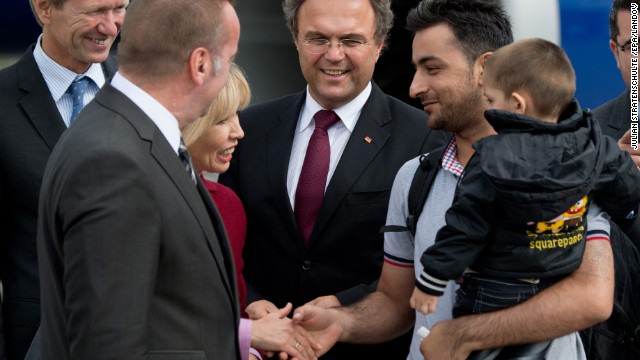 Lower Saxony's Commissioner for Migration and Participation Doris Schroeder-Koempf, along with German Interior Minister Hans-Peter Friedrich, center, greet the first of many Syrian refugees that have been granted temporary asylum in Germany on Wednesday, September 11. According to the The United Nations refugee agency, the refugees will be issued with a permit to stay for at least two years. The agency said that the number of Syrians who have fled their war-ravaged country has risen to more than 2 million.
Lower Saxony's Commissioner for Migration and Participation Doris Schroeder-Koempf, along with German Interior Minister Hans-Peter Friedrich, center, greet the first of many Syrian refugees that have been granted temporary asylum in Germany on Wednesday, September 11. According to the The United Nations refugee agency, the refugees will be issued with a permit to stay for at least two years. The agency said that the number of Syrians who have fled their war-ravaged country has risen to more than 2 million. 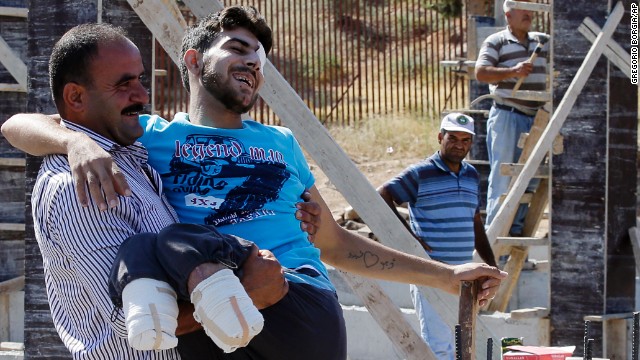 Mustafa Abu Bekir, who was wounded while fighting with the Free Syrian Army, smiles as he meets relatives after crossing the Cilvegozu gate border in Turkey's Hatay province on Monday, September 9.
Mustafa Abu Bekir, who was wounded while fighting with the Free Syrian Army, smiles as he meets relatives after crossing the Cilvegozu gate border in Turkey's Hatay province on Monday, September 9. 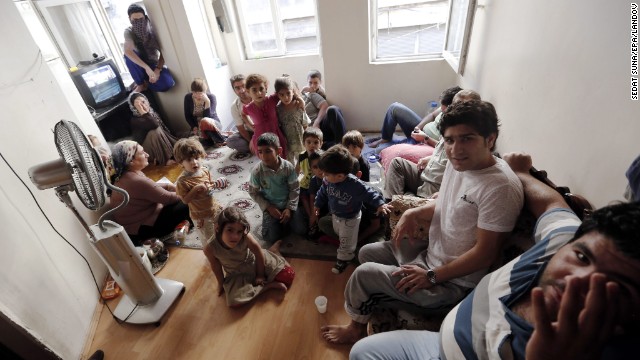 A Syrian refugee family of 26 people shares one room in the Eminonu district in Istanbul, Turkey, on September 9. The family fled Syria seven months ago.
A Syrian refugee family of 26 people shares one room in the Eminonu district in Istanbul, Turkey, on September 9. The family fled Syria seven months ago. 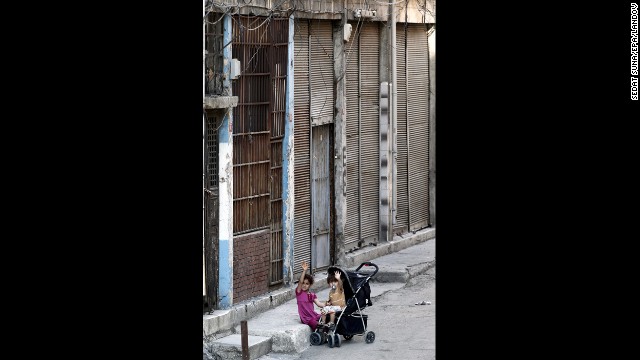 Two Syrian refugee children sit outside a house where they currently live in Istanbul on September 9.
Two Syrian refugee children sit outside a house where they currently live in Istanbul on September 9. 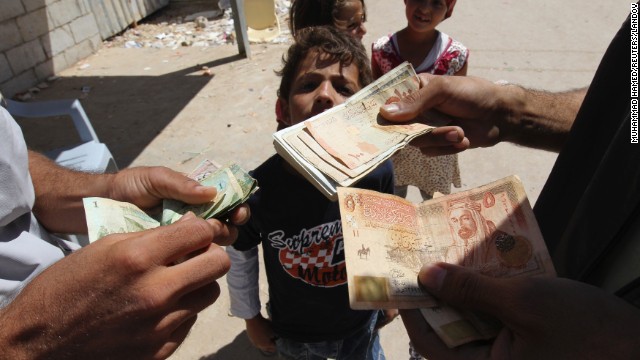 A refugee money-changer exchanges currency at the main market at the Zaatari refugee camp near the Jordanian city of Mafraq on Sunday, September 8.
A refugee money-changer exchanges currency at the main market at the Zaatari refugee camp near the Jordanian city of Mafraq on Sunday, September 8. 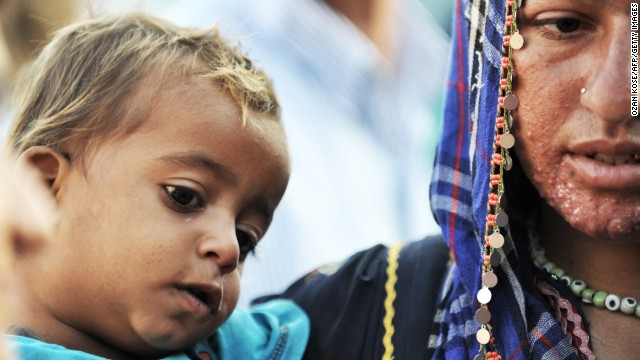 A woman from an Alawite neighborhood in Syria holds her son on September 8 at the Pir Sultan Abdal foundation in Istanbul, which belongs to the Turkish Alawite community. Around 2000 Syrian Alawite refugees came to Istanbul in recent months to escape violence in North Syria.
A woman from an Alawite neighborhood in Syria holds her son on September 8 at the Pir Sultan Abdal foundation in Istanbul, which belongs to the Turkish Alawite community. Around 2000 Syrian Alawite refugees came to Istanbul in recent months to escape violence in North Syria. 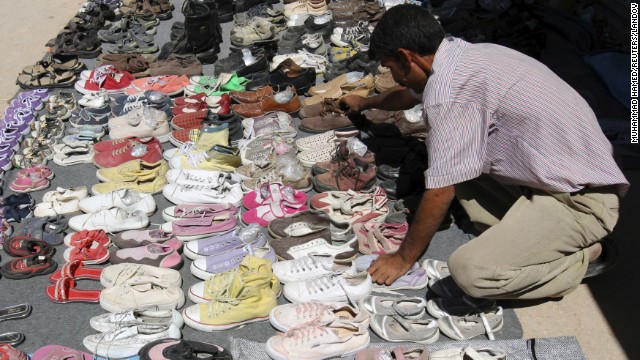 A Syrian refugee displays second-hand shoes for sale at the main market at the Zaatari Refugee Camp close to the Jordanian city of Mafraq, near the border with Syria, on September 8.
A Syrian refugee displays second-hand shoes for sale at the main market at the Zaatari Refugee Camp close to the Jordanian city of Mafraq, near the border with Syria, on September 8. 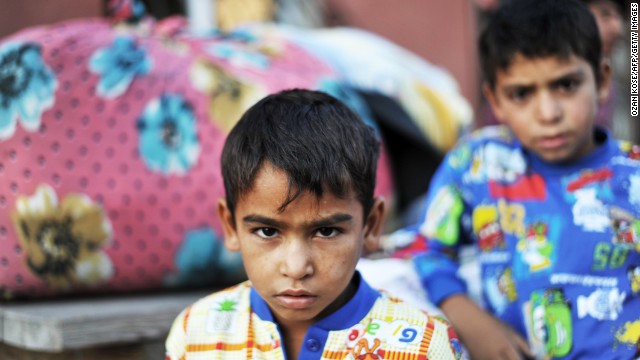 Syrian refugees arrive at the Pir Sultan Abdal foundation in Istanbul on September 8.
Syrian refugees arrive at the Pir Sultan Abdal foundation in Istanbul on September 8. 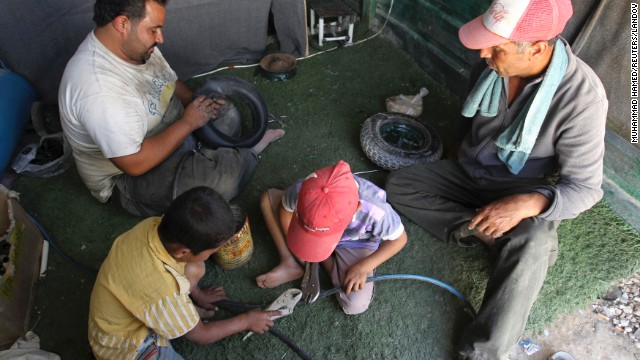 Syrian refugee workers fix cart wheels at their shop at the Zaatari Refugee Camp on September 8. Jordan has 515,000 registered Syrian refugees.
Syrian refugee workers fix cart wheels at their shop at the Zaatari Refugee Camp on September 8. Jordan has 515,000 registered Syrian refugees. 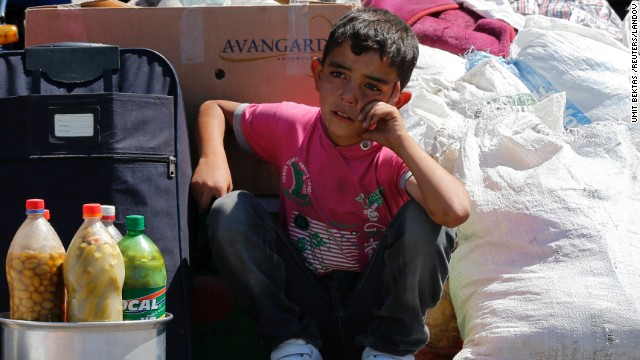 A Syrian boy sits beside his family's belongings on Friday, September 6, as they wait for a vehicle to pick them up after entering Turkey from the Turkish border gate of Cilvegozu.
A Syrian boy sits beside his family's belongings on Friday, September 6, as they wait for a vehicle to pick them up after entering Turkey from the Turkish border gate of Cilvegozu. 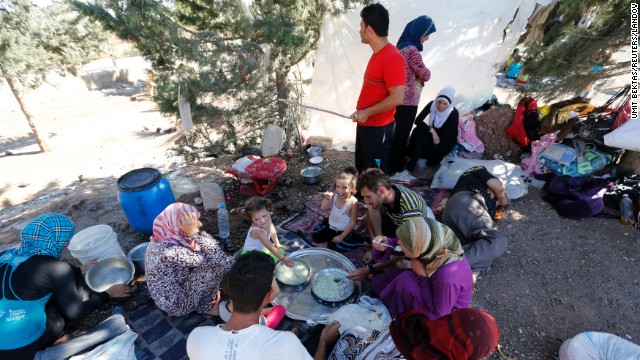 Syrian refugees who failed to find shelters in a refugee camp eat and rest by the side of a road a few meters away from the Turkish-Syrian border on Thursday, September 5.
Syrian refugees who failed to find shelters in a refugee camp eat and rest by the side of a road a few meters away from the Turkish-Syrian border on Thursday, September 5. 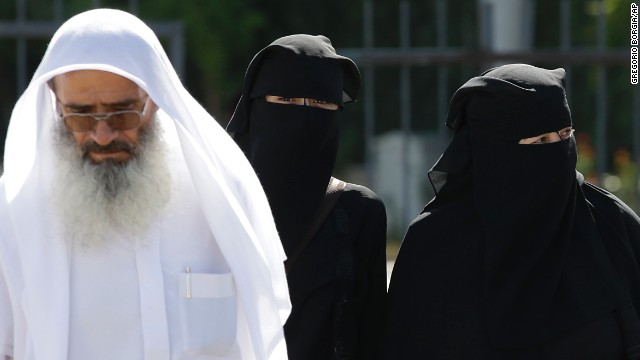 Syrian refugees arrive at the Turkish border gate of Cilvegozu on Thursday, September 5.
Syrian refugees arrive at the Turkish border gate of Cilvegozu on Thursday, September 5. 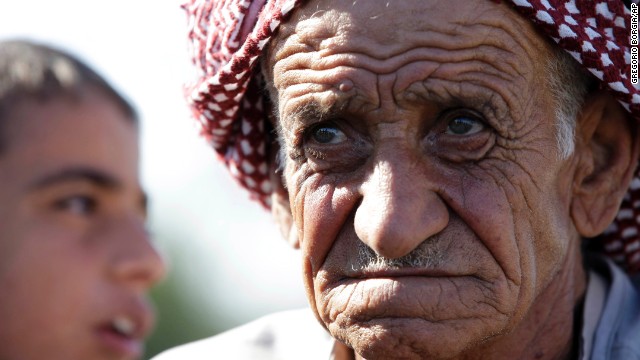 Syrian refugees gather in the village of Salkin after crossing the Syrian-Turkish border on September 5.
Syrian refugees gather in the village of Salkin after crossing the Syrian-Turkish border on September 5. 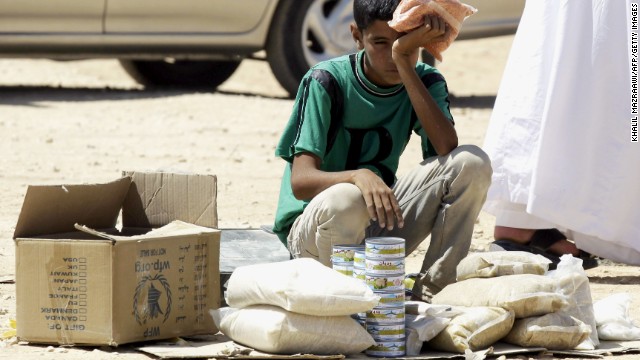 A young Syrian refugee boy sells canned tuna and other food items in the Zaatari Refugee Camp on September 4.
A young Syrian refugee boy sells canned tuna and other food items in the Zaatari Refugee Camp on September 4. 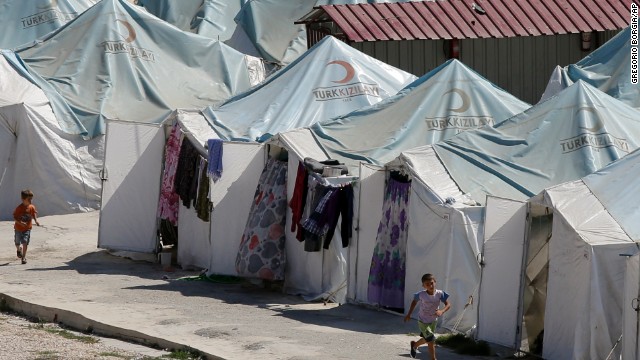 Children run past tents at a Syrian refugee camp in Yayladagi, Turkey, on September 3.
Children run past tents at a Syrian refugee camp in Yayladagi, Turkey, on September 3. 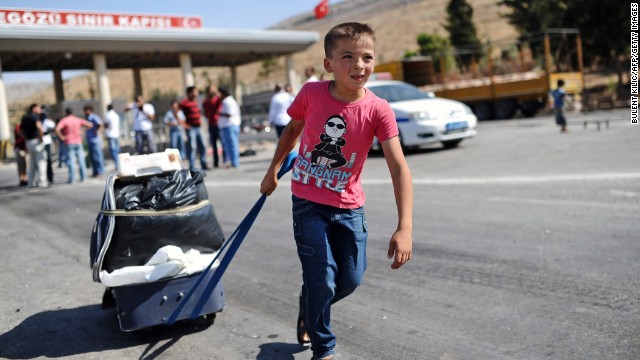 A child pulls a suitcase as Syrian refugees arrive at the Cilvegozu crossing gate of Reyhanli in Turkey's Hatay province on Saturday, August 31.
A child pulls a suitcase as Syrian refugees arrive at the Cilvegozu crossing gate of Reyhanli in Turkey's Hatay province on Saturday, August 31. 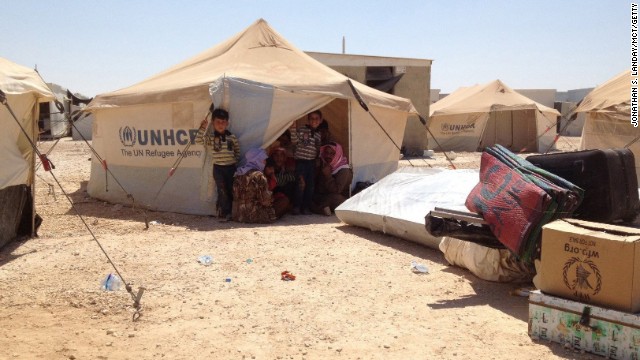 A family arrives from Syria at the Zaatari refugee camp in Jordan on Friday, August 30.
A family arrives from Syria at the Zaatari refugee camp in Jordan on Friday, August 30. 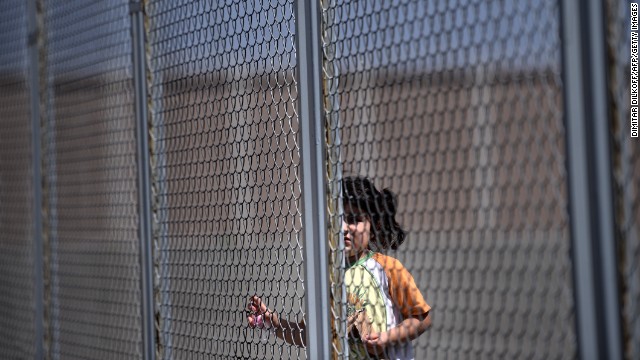 A Syrian girl stands behind a fence at Bulgaria's shelter near Lyubimets on August 28. More than 3,100 immigrants -- half of them Syrians -- have crossed into Bulgaria from neighboring Turkey this year, doubling their numbers compared with 2012 and and causing Bulgaria's few temporary accommodation facilities to overflow.
A Syrian girl stands behind a fence at Bulgaria's shelter near Lyubimets on August 28. More than 3,100 immigrants -- half of them Syrians -- have crossed into Bulgaria from neighboring Turkey this year, doubling their numbers compared with 2012 and and causing Bulgaria's few temporary accommodation facilities to overflow. 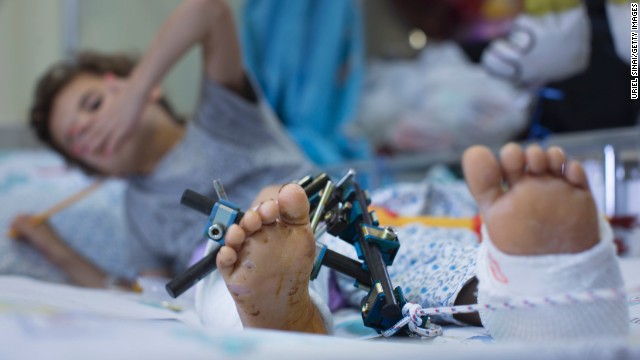 A wounded Syrian child is treated at the Israeli Ziv hospital on Wednesday, August 28, in the northern town of Safed, Israel. About 140 wounded Syrians, who have been fighting across the border from Israel, have been treated in Israeli hospitals since the beginning of the Syrian Civil war.
A wounded Syrian child is treated at the Israeli Ziv hospital on Wednesday, August 28, in the northern town of Safed, Israel. About 140 wounded Syrians, who have been fighting across the border from Israel, have been treated in Israeli hospitals since the beginning of the Syrian Civil war. 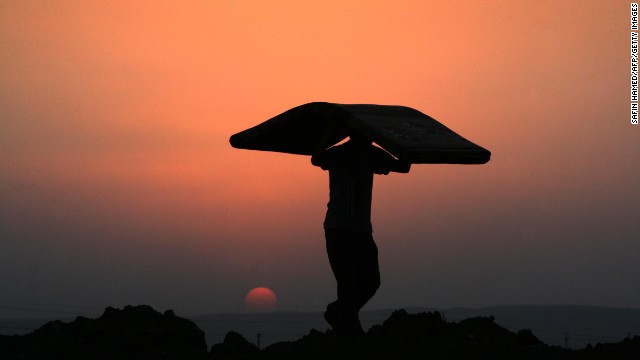 A Syrian-Kurdish man carries a mattress at sunset at the Quru Gusik refugee camp, east of Arbil, the capital of the autonomous Kurdish region of northern Iraq, on Tuesday, August 27. More than 50,000 Syrian refugees have crossed into Iraq's Kurdish region in less than two weeks as authorities rush to house them in more permanent camps.
A Syrian-Kurdish man carries a mattress at sunset at the Quru Gusik refugee camp, east of Arbil, the capital of the autonomous Kurdish region of northern Iraq, on Tuesday, August 27. More than 50,000 Syrian refugees have crossed into Iraq's Kurdish region in less than two weeks as authorities rush to house them in more permanent camps. 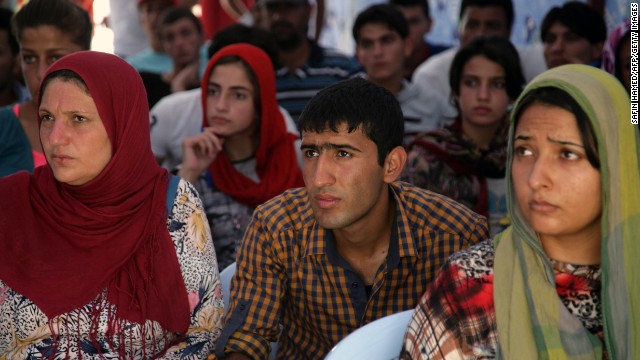 Syrian refugees listen to safety instructions at the Quru Gusik refugee camp on Saturday, August 24.
Syrian refugees listen to safety instructions at the Quru Gusik refugee camp on Saturday, August 24. 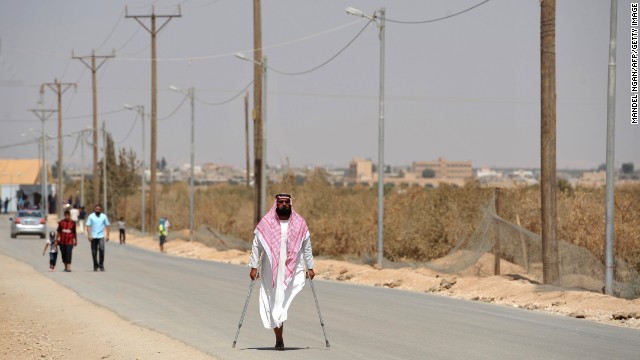 Syrian refugees at the Zaatari refugee camp on Thursday, July 18, near the Jordanian city of Mafraq, near the Jordanian-Syrian border.
Syrian refugees at the Zaatari refugee camp on Thursday, July 18, near the Jordanian city of Mafraq, near the Jordanian-Syrian border. 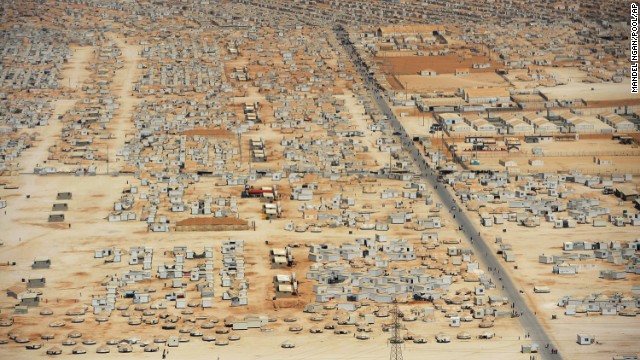 The expanse of the Zaatari refugee camp in Jordan as seen from an aerial view on July 18. The camp was opened on July 28, 2012, and is home to more than 130,000 refugees.
The expanse of the Zaatari refugee camp in Jordan as seen from an aerial view on July 18. The camp was opened on July 28, 2012, and is home to more than 130,000 refugees. 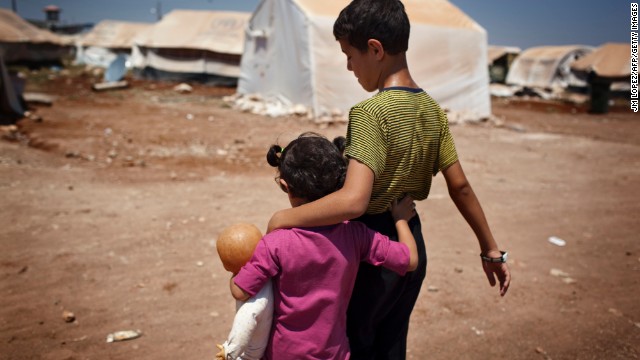 Syrian refugee children walk in the Bab al-Salam refugee camp in Syria's northern city of Azaz on Monday, July 15.
Syrian refugee children walk in the Bab al-Salam refugee camp in Syria's northern city of Azaz on Monday, July 15. 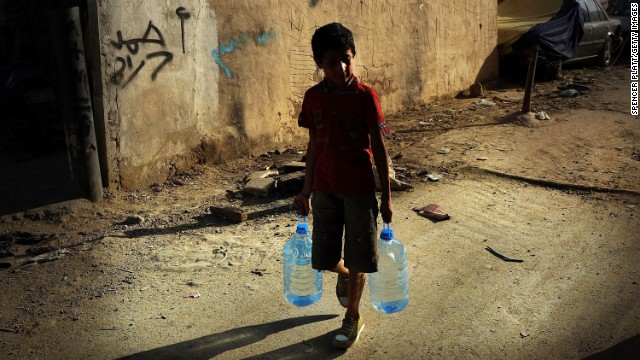 A boy walks with jugs of water on June 27 in a neighborhood in Beirut, Lebanon, with a high concentration of Syrian refugees. Since January, the number of Syrian refugees in Lebanon has more than tripled.
A boy walks with jugs of water on June 27 in a neighborhood in Beirut, Lebanon, with a high concentration of Syrian refugees. Since January, the number of Syrian refugees in Lebanon has more than tripled.  Syrian refugees stand with their belongings on June 20, World Refugee Day, at Zaatari refugee camp in Jordan.
Syrian refugees stand with their belongings on June 20, World Refugee Day, at Zaatari refugee camp in Jordan. 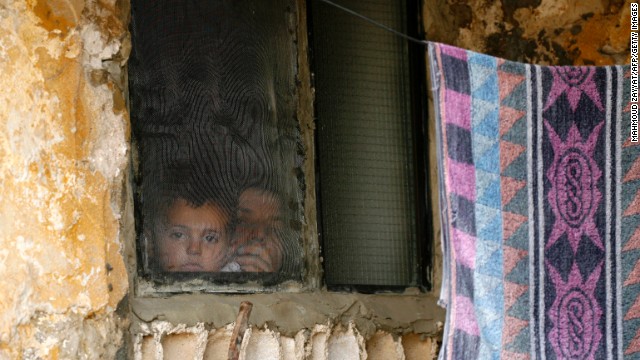 A Syrian woman and child look out of a refugee camp window on June 20 in Alman, Lebanon, after fleeing their hometown in Idlib province, Syria.
A Syrian woman and child look out of a refugee camp window on June 20 in Alman, Lebanon, after fleeing their hometown in Idlib province, Syria. 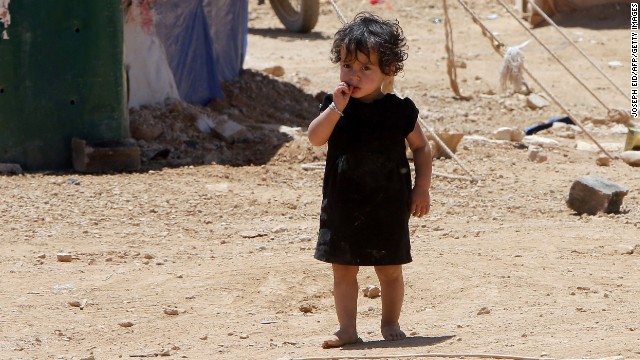 A child, whose family fled violence in Syria, stands at the Arsal refugee camp on June 14 in Lebanon's Bekaa Valley.
A child, whose family fled violence in Syria, stands at the Arsal refugee camp on June 14 in Lebanon's Bekaa Valley. 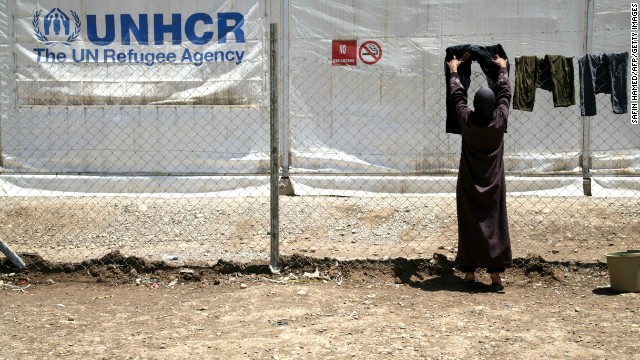 A woman uses a fence at the Domiz refugee camp near Kohuk, Iraq, to dry laundry on May 29.
A woman uses a fence at the Domiz refugee camp near Kohuk, Iraq, to dry laundry on May 29. 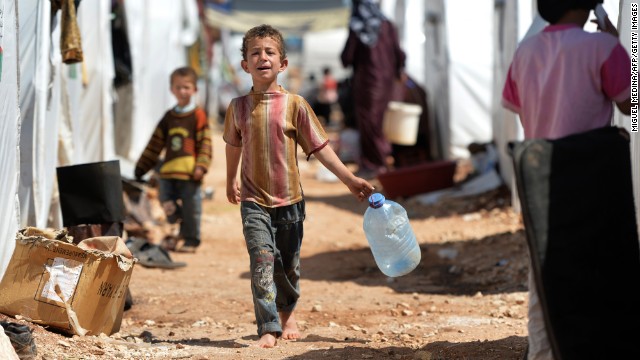 A boy carries a jug for water at the Maliber al-Salam refugee camp on April 28. The camp, located near the Turkish boarder, houses internally displaced Syrian families.
A boy carries a jug for water at the Maliber al-Salam refugee camp on April 28. The camp, located near the Turkish boarder, houses internally displaced Syrian families. 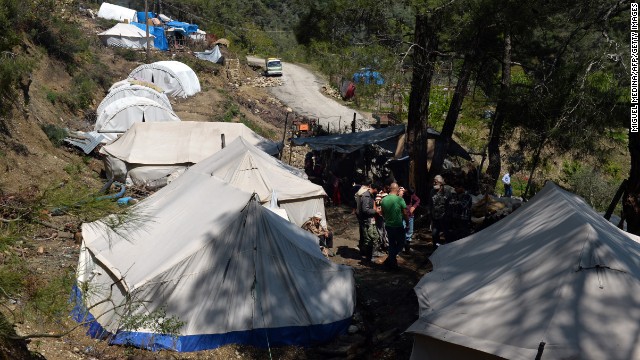 A makeshift refugee camp is seen near Syria's border with Turkey.
A makeshift refugee camp is seen near Syria's border with Turkey. 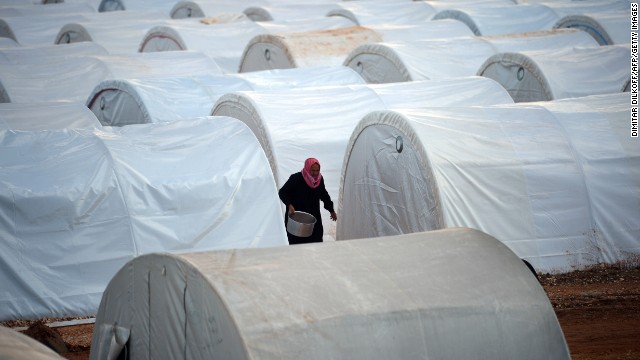 Row after row of temporary shelters fill the Maiber al-Salam refugee camp in Syria's Aleppo province, near the Turkish border on April 17.
Row after row of temporary shelters fill the Maiber al-Salam refugee camp in Syria's Aleppo province, near the Turkish border on April 17. 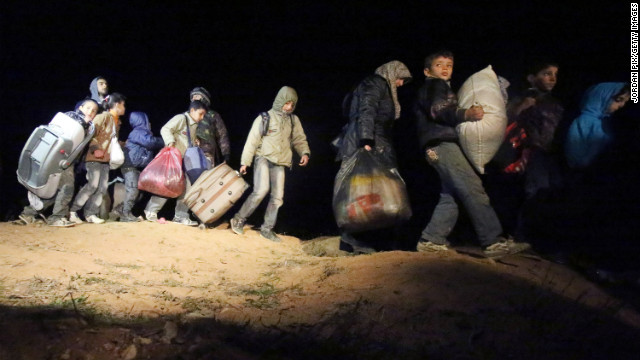 Refugees fleeing the conflict in Syria arrive February 18 at the Jordanian border.
Refugees fleeing the conflict in Syria arrive February 18 at the Jordanian border.  A Syrian girl stands at the entrance of a makeshift home near ruins in the ancient city of Serjilla in northwestern Syria on February 11. About half of Syria's refugees are children.
A Syrian girl stands at the entrance of a makeshift home near ruins in the ancient city of Serjilla in northwestern Syria on February 11. About half of Syria's refugees are children. 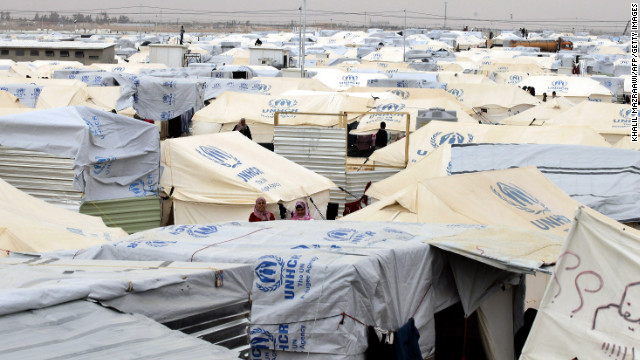 More than 400,000 people have fled Syria this year to countries including Lebanon, Jordan, Turkey, Iraq and Egypt. The Zaatari refugee camp is in Jordan, near the Syrian border.
More than 400,000 people have fled Syria this year to countries including Lebanon, Jordan, Turkey, Iraq and Egypt. The Zaatari refugee camp is in Jordan, near the Syrian border.  A refugee collects apples and some bread February 10 at the Azaz refugee camp along the Syrian-Turkish border. Turkey has spent more than $600 million setting up 17 refugee camps, with more under construction.
A refugee collects apples and some bread February 10 at the Azaz refugee camp along the Syrian-Turkish border. Turkey has spent more than $600 million setting up 17 refugee camps, with more under construction. 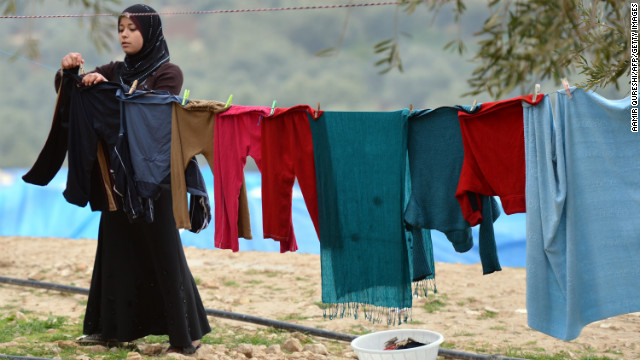 Clothes dry at the Qah refugee camp near the Turkish border on January 31. Many Syrians are forced to flee with few or no belongings.
Clothes dry at the Qah refugee camp near the Turkish border on January 31. Many Syrians are forced to flee with few or no belongings. 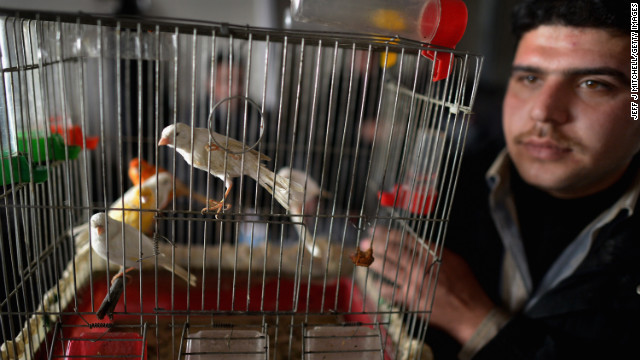 A man shows off his pet birds as new Syrian refugees arrive at the International Organization for Migration at the Zaatari refugee camp on January 30.
A man shows off his pet birds as new Syrian refugees arrive at the International Organization for Migration at the Zaatari refugee camp on January 30.  A refugee child gets a haircut at a makeshift barbershop at the Azaz refugee camp on February 19.
A refugee child gets a haircut at a makeshift barbershop at the Azaz refugee camp on February 19. 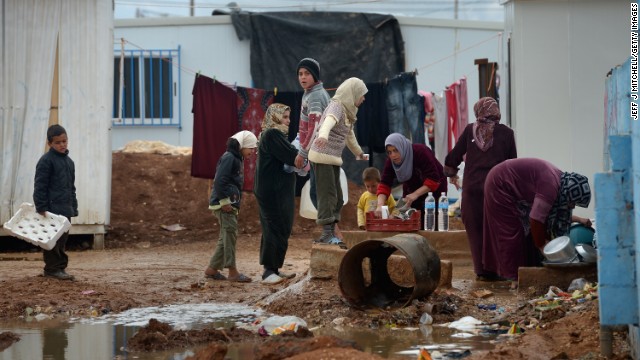 Syrian children gather around women washing in the Zaatari refugee camp on January 31.
Syrian children gather around women washing in the Zaatari refugee camp on January 31. 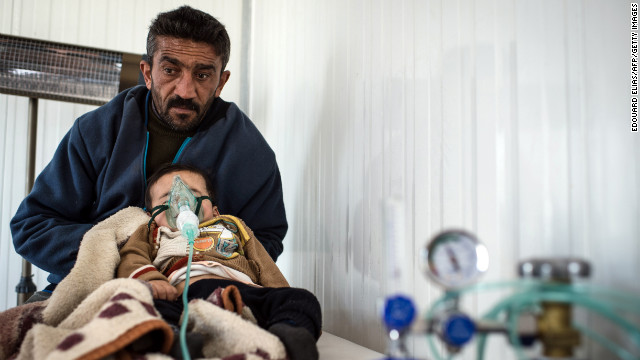 A refugee visits a clinic with his child at the Azaz refugee camp on February 10.
A refugee visits a clinic with his child at the Azaz refugee camp on February 10. 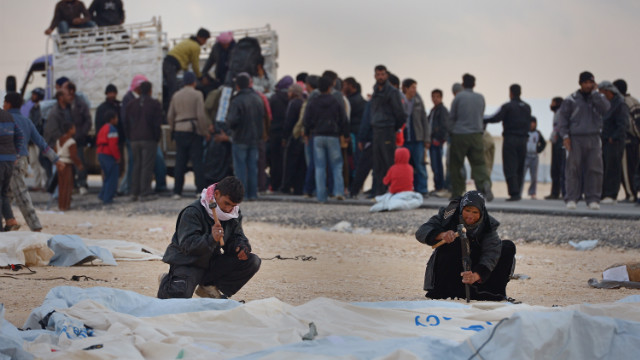 Syrians put up tents at the Zaatari refugee camp on January 30.
Syrians put up tents at the Zaatari refugee camp on January 30. 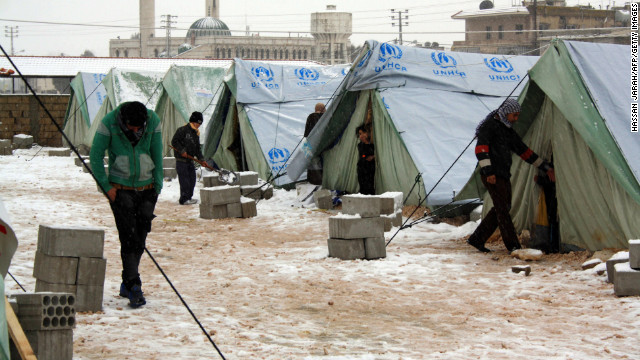 The U.N. High Commissioner for Refugees supplied tents in Al-Marj, in the eastern Lebanese Bekaa Valley. Some families have endured frigid weather in tent camps or struggle to pay for shelter.
The U.N. High Commissioner for Refugees supplied tents in Al-Marj, in the eastern Lebanese Bekaa Valley. Some families have endured frigid weather in tent camps or struggle to pay for shelter. 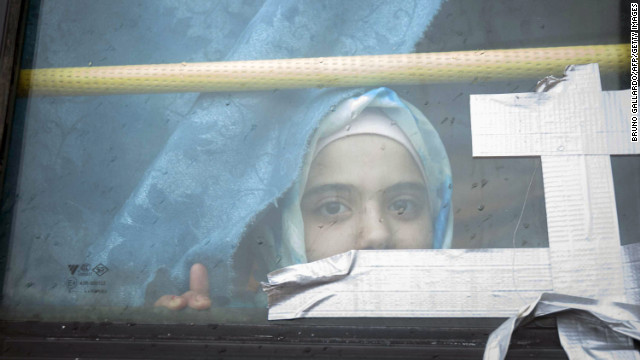 A Syrian girl looks through the window of a bus where she has lived with her family for the past eight months at a refugee camp in Bab al-Salam on the Syria-Turkey border on February 28.
A Syrian girl looks through the window of a bus where she has lived with her family for the past eight months at a refugee camp in Bab al-Salam on the Syria-Turkey border on February 28. 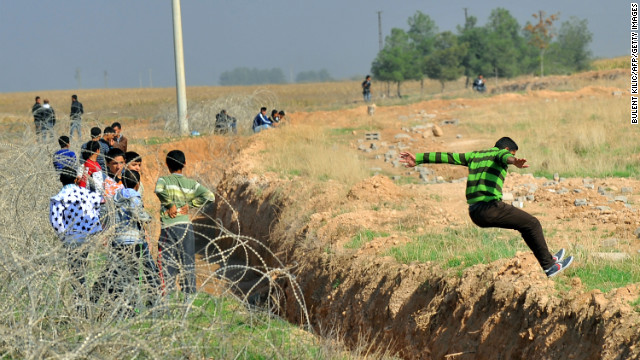 A Syrian jumps across the border between the Syrian town of Ras al-Ain and Ceylanpinar in Turkey's Sanliurfa province on November 10, 2012.
A Syrian jumps across the border between the Syrian town of Ras al-Ain and Ceylanpinar in Turkey's Sanliurfa province on November 10, 2012. 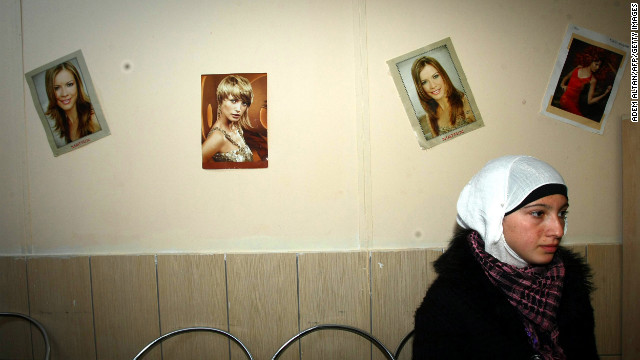 A Syrian refugee waits November 27, 2012, at a hairdresser's shop, where refugees can also receive training, inside the Oncupinar camp in Kilis, southern Turkey.
A Syrian refugee waits November 27, 2012, at a hairdresser's shop, where refugees can also receive training, inside the Oncupinar camp in Kilis, southern Turkey. 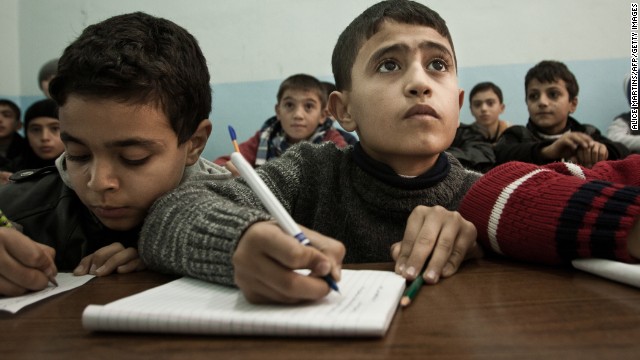 A Syrian boy attends school in the Turkish town of Kilis on December 17, 2012.
A Syrian boy attends school in the Turkish town of Kilis on December 17, 2012. 
1

2

3

4

5

6

7

8

9

10

11

12

13

14

15

16

17

18

19

20

21

22

23

24

25

26

27

28

29

30

31

32

33

34

35

36

37

38

39

40

41

42

43

44

45

46

47
- Leila Hilal: Securing Syria's chemical weapons is a partial measure but could be first step
- She says it's a "big if," but such an agreement would fuel other efforts to end Syria war
- Hilal: The ultimate goal of diplomacy is a political settlement that would end the suffering
Editor's note: Leila Hilal is director of the Middle East Task Force at the New America Foundation.
(CNN) -- Let's be clear: An agreement that would put Syria's chemical weapons under U.N. lock and key is not a solution. It is a partial measure that could help U.S. officials avoid the uncomfortable task of having to authorize military strikes in the face of clear public opposition and save the Syrian people from further gas attacks.
That is, of course, if it works. And that is a big if. As history has shown, previous cease-fire agreements under U.N. leadership have failed to gain the compliance of Bashar al-Assad.
More to the point is that confronting the scourge of the humanitarian disaster consuming Syria and threatening neighbors is not dependent on removing access to chemical weapons. More than 200,000 people have been counted as killed, more than 6 million have been displaced and millions of Syrians are facing starvation and death by common disease. These casualties are not the result of chemical attacks. They are the result of a protracted civil war in which the Assad regime carries the disproportionate blame for atrocities.
But let's also be clear about what is at stake now. After two years of military stalemate, a diplomatic breakthrough involving key protagonists in Syria's war would be no insignificant feat.
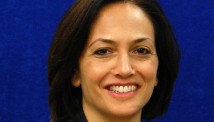
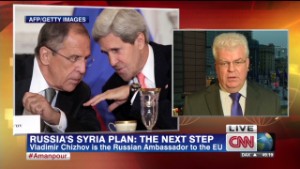 Russia's Syria plan: The next step
Russia's Syria plan: The next step 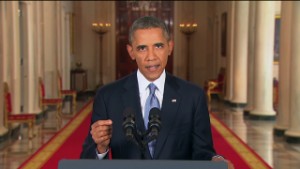 History behind Obama's speech
History behind Obama's speech Russia, which has long given al-Assad cover from international censure, agreed to the diplomatic proposal publicly floated by U.S. Secretary of State John Kerry in London. China has registered its acquiescence. France drafted a resolution listing tough parameters for a disarmament deal, parts of which were rejected by Russia, which submitted a counterdraft.
All eyes turn to Geneva talks on Syria
That negotiations are taking place at the U.N. Security Council is significant. Although Samantha Power, U.S. ambassador to the United Nations, signaled at a news briefing Tuesday that substantial differences remain between the United States and Russia that could very well end in deadlock, should a resolution be adopted, it will likely reflect the agreement of the Syrian government and Iran -- both of which have a role to play in achieving an eventual resolution.
With Iran backing Syria materially with money, strategic military advice and fighters, observers of Syria have long understood that its participation would be necessary to getting a viable political plan moving. The Iranian Foreign Ministry has voiced its support for the plan.
If Russia and Iran were in agreement with the United States, a diplomatic framework aimed at a de-escalation of the civil war would be in place.
Enforcement opportunities would be increased if such an agreement were adopted in a Security Council resolution. This could in turn usher in an avenue for a broader initiative to de-escalate violence in Syria. In fact, a U.N. weapons inspection team operating in Syria would by its very presence likely bring about a decrease of violence alone.
There are many that are rightly skeptical of the chances of success at the United Nations, but all indications are negotiations between the United States and Russia have been ongoing since President Barack Obama announced his intention to use force against the Syrian government.
These negotiations should be allowed to bear fruit without unnecessary posturing that could scare off the Russians.
Insisting on language that al-Assad should go is not worth the risk of losing this opportunity. Al-Assad's legitimacy has been clearly squandered to the point of no return. As the parties are to go to the table for "Geneva II" negotiations, the diplomatic track initiated by Russia and the United States to resolve the conflict politically, discussion will undoubtedly begin from the premise of the need to transition Syria to new leadership.
The Syrian opposition holds this strong card that few can dispute, although the timelines and details of the transition still need to be worked out.
American and European negotiators should also consider whether it is worth fighting for a resolution falling under Chapter VII of the U.N. Charter.
Chapter VII, invoked to authorize international intervention in Iraq, Libya and the Democratic Republic of the Congo, would back up any U.N. deal with enforcement powers, ranging from sanctions to military force. The issue, however, constitutes a contentious point in the negotiations.
It appears clear that by threatening military intervention, Obama was able to advance Syria's conflict toward a potential point of agreement for action. The United States should reserve that right to use force within a particular timeline but without letting it become a stumbling block at the Security Council.
The administration should also continue to make the case to the American people that Syria's suffering didn't start with chemical weapons and will not end in the chance that they are secured or destroyed.
If these negotiations are to be a real opportunity, they must be viewed as a step toward a larger political initiative to achieve conditions for a negotiated transition from civil war to relative stability and eventually the democratic Syria for which so many have sacrificed.
Follow @CNNOpinion on Twitter.
Join us at Facebook/CNNOpinion.
The opinions expressed in this commentary are solely those of Leila Hilal.







